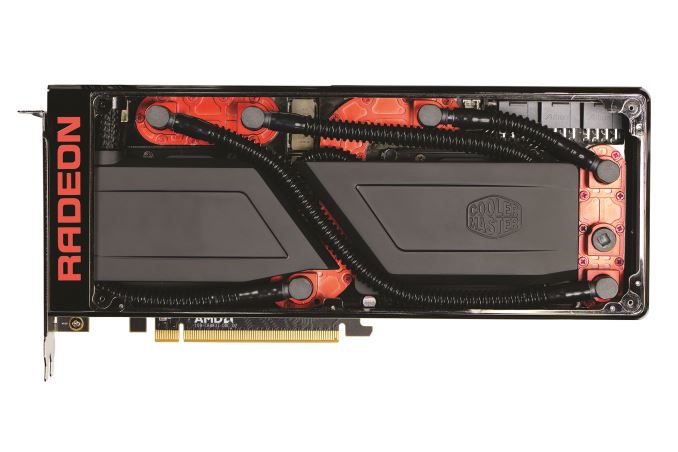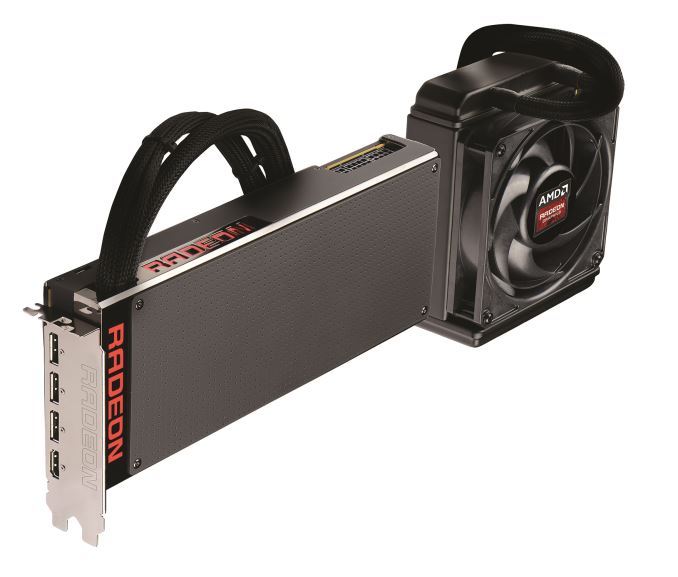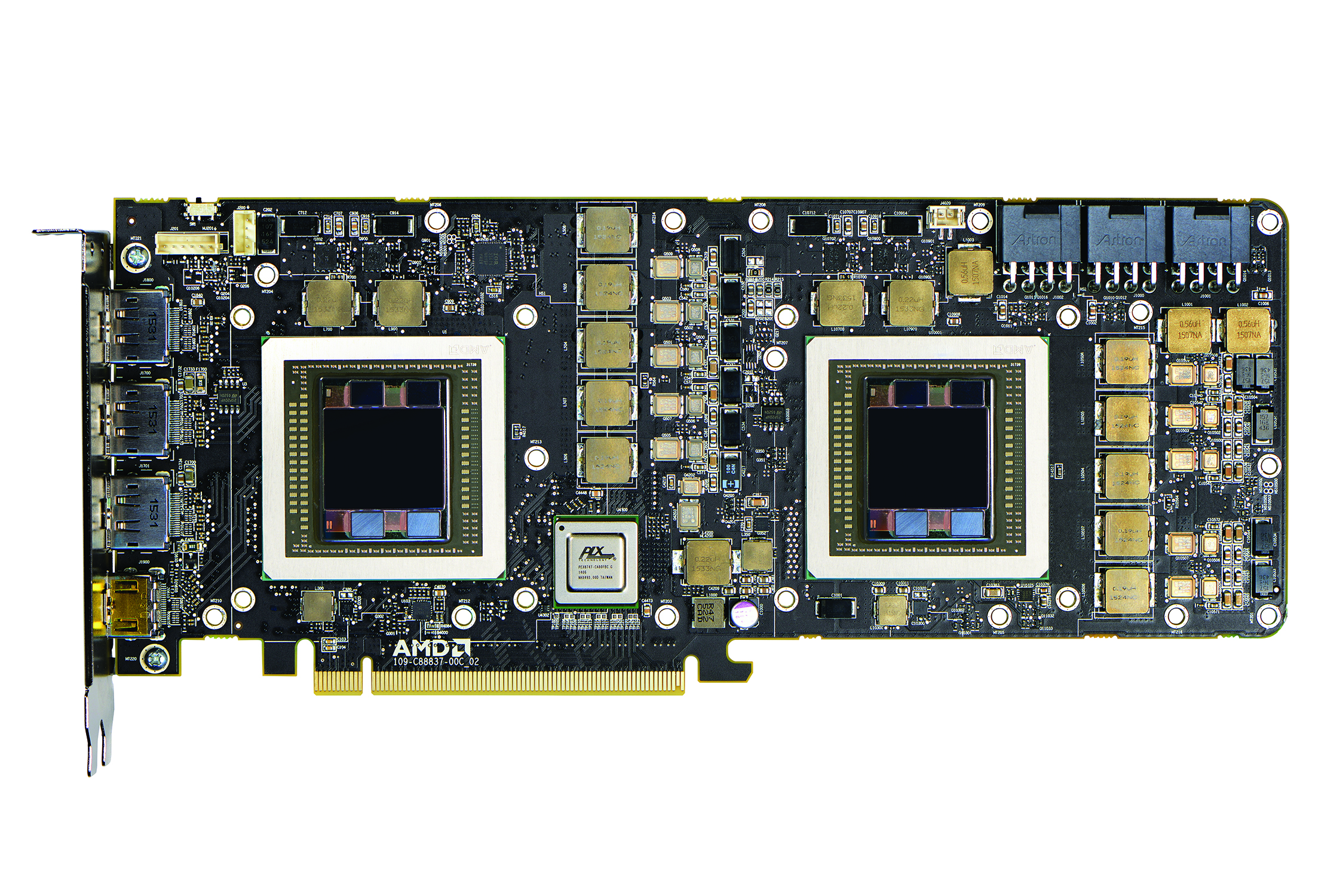AMD Releases Radeon Pro Duo: Dual Fiji, 350W, $1500
by Daniel Williams on April 26, 2016 9:00 AM EST
These recent years we have seen a slow but steady buildup of VR from both technological developments to growing enthusiasm shown by consumers and the industry. Today AMD is releasing the Radeon Pro Duo to the market as their first card targeted at VR developers. This card is not being directly aimed at gamers, despite the capability under the hood, but focuses on official support for professional software. Additionally, multiple initiatives are being both spearheaded and supported by AMD and others to encourage growth in the VR sector.
The AMD Radeon Pro Duo was first announced back in March, with the card is being marketed for VR content creation first and foremost. With this card, AMD is promoting the ability to allocate one GPU per eye while powering VR experiences. This way the case is opened up for performance beyond what any other single card can offer today. Another use case for developers is offloading compute work to the second GPU while the first is used for graphical work which can make for a much smoother experience during demanding a workflow.
Gaming is definitely possible on Radeon Pro Duo and alongside the FirePro drivers for content creators, Radeon drivers will be available. The Pro Duo will not see validation for as many applications as a true FirePro card, but official support will be provided for applications important to gaming content creation such as Autodesk, Maya, and Blackmagic Davinci Resolve.
| AMD GPU Specification Comparison | ||||||
| AMD Radeon Pro Duo | AMD Radeon R9 Fury X | AMD Radeon R9 Fury | AMD Radeon R9 295X2 | |||
| Stream Processors | 2 x 4096 | 4096 | 3584 | 2 x 2816 | ||
| Texture Units | 2 x 256 | 256 | 224 | 2 x 176 | ||
| ROPs | 2 x 64 | 64 | 64 | 2 x 64 | ||
| Boost Clock | 1000MHz | 1050MHz | 1000MHz | 1018MHz | ||
| Memory Clock | 1Gbps HBM | 1Gbps HBM | 1Gbps HBM | 5Gbps GDDR5 | ||
| Memory Bus Width | 2 x 4096-bit | 4096-bit | 4096-bit | 2 x 512-bit | ||
| VRAM | 2 x 4GB | 4GB | 4GB | 2 x 4GB | ||
| FP64 | 1/16 | 1/16 | 1/16 | 1/8 | ||
| TrueAudio | Y | Y | Y | Y | ||
| Transistor Count | 2 x 8.9B | 8.9B | 8.9B | 2 x 6.2B | ||
| Typical Board Power | 350W | 275W | 275W | 500W | ||
| Manufacturing Process | TSMC 28nm | TSMC 28nm | TSMC 28nm | TSMC 28nm | ||
| Architecture | GCN 1.2 | GCN 1.2 | GCN 1.2 | GCN 1.1 | ||
| GPU | Fiji | Fiji | Fiji | Hawaii | ||
| Launch Date | Q2 2016 | 06/24/2015 | 07/14/2015 | 04/21/2014 | ||
| Launch Price | $1499 | $649 | $549 | $1499 | ||
The Radeon Pro Duo is essentially and effectively two Radeon R9 Nanos together on a single PCB. At a high level, the Pro Duo should give us up to twice the performance at twice the power consumption (plus a bit extra for PCIe switches). To remove heat, the card comes with a closed loop cooler similar to that found on AMD’s Radeon R9 Fury X. This cooler, unlike the one found on the R9 295X2, provides a complete liquid cooling solution covering the VRMs on both GPUs along with the GPUs themselves. For reference, the pipes on this one are 540 mm long, and the double-thick radiator with fan comes in at 63 mm
Moving past the cooling solution we get three full sized DisplayPort connectors and one full-size HDMI port. On the side of the card there are three 8-pin PCIe power connectors which will do more than an adequate job of supplying the rated 350W power draw. Note that 350W is the equivalent of dual R9 Nano cards (rated at 175W a piece), and will be clocked similarly. The reactive frequency adjustments to heavily loading, by inference, are likely to be similar but we expect AMD to be using low-power binned parts for their new high-end card.
The Radeon Pro Duo is launching today at $1500, or three times the current price of the R9 Nano. That’s a $500 price premium to combine two cards into one. Even with the price, AMD is keen to admit that the Radeon Pro Duo is now the single fastest graphics card on the market since the competition doesn’t offer a similar product at this time. From our perspective at AnandTech, we still advise that users are better off investing in a single powerful GPU first, and only scaling out into SLI/CF when requirements for extreme performance are such that a single GPU solution cannot provide. With VR, it stands a good chance at pushing gaming machines harder than anything we’ve seen so far, especially when trying to maintain a smooth and low latency experience. It all depends on the workflow and subsequent frame rendering methods used.
Alongside all of this news and information is renewed attention for several initiatives AMD is taking part in. AMD has placed the Radeon Pro Duo as the first card in their AMD VR Ready Creator Line. The goal being that the Pro Duo, coupled with Liquid VR, will create a powerful and capable platform to develop future VR experiences. The AMD VR Ready Creator Line is also the platform of choice for Crytek’s VR First initiative, which intends to foster growth in the VR industry by supporting developers by powering virtual reality labs in colleges and universities around the world.
We are approaching a crossroads between the outgoing GPU generation and the upcoming cards coming out later this year. The Radeon Pro Duo is part of an outgoing generation but aims to provide a competent platform for VR content creation following known architecture guidelines. Along with the new hardware released today, there are many initiatives in motion that aim to encourage growth in VR, and new hardware will continue to be an important tool for creating innovative experiences moving forward.
We have already seen Tmall post up an early listing for an XFX variant of the Pro Duo, and retailers should be showing other OEMs variants today as well. At current, AMD's base design is expected to be the sole variant of the Pro Duo.
Source: AMD


























63 Comments
View All Comments
abufrejoval - Tuesday, April 26, 2016 - link
So why would I not simply use two Nanos? Because there is only one HDMI connector on the VR headset? So the 500 buck premium is about multiplexing a signal which will get de-multiplexed on the headset? Seems a bad deal, in a way, although I'd rather like to have 0 cables instead of 2 and I guess that would be worth $500 extra....I had a Nano for about two weeks until I got cold feed about slow frame rates on Prepar3d using the Oculus plug-in (turned out it wasn't a Nano issue) and returned it while I could for a full refund.
I must say at €500 it was quite (and quiet) a nice card and exactly the value it failed to be at €700.
Yes the GTX 980ti which replaced it is as much faster as it is more expensive, but physically a brute compared to that Nano cutie...
A dual Nano sounds good, but I'd only get interested once it drops to 2x Nano price.
Seems Avago hiked those PLX prices after they bougth the company to pay for the purchase and that is perhaps a large part of the premium.
vladx - Tuesday, April 26, 2016 - link
"So why would I not simply use two Nanos? "One word: latency. That's more important in VR development than price.
samer1970 - Tuesday, April 26, 2016 - link
the same latency , this card uses a plx switch chip which splits the 16x pci express into 2 virtual 16X slots ... this is actually SLOWER than using two REAL 16X slots on an X99 motherboard !two Nanos in CF is FASTER than this card .
Beany2013 - Tuesday, April 26, 2016 - link
It might be marginally slower, but you need to consider heat, power, compute density and complexity - of which this card should be far less of a concern on each point than a crossfire setup.Those are things you avoid in the professional world where stability and uptime are king.
samer1970 - Tuesday, April 26, 2016 - link
this IS a cross fire setup. inside the card ... it is simply the 16X slot divided into 2x16 slots using plx switch chip , namely the plx 8747 , which connects to the cpu telling it that it has 2x16 slots instead of one and gives electrical 2x16 slots connection for 2 GPU on that board , the design on the board is a CF design 100% each chip is connected to the PLX chip via 16 virtual lanes (look at it as if there are 2 virtual lots now used ...some motherboards include this plx chip to give you virtual 2x16 slots ... it is the same 100%
svan1971 - Tuesday, April 26, 2016 - link
I'm sorry but isn't a new chip due out this summer that's promising a 50% speed increase doubling the current ram, running cooler and more power efficient? If your buying this card you have money to burn.Gigaplex - Tuesday, April 26, 2016 - link
"At a high level, the Pro Duo should give us up to twice the performance at twice the power consumption (plus a bit extra for PCIe switches)."The rated power consumption has "only" jumped from 275W to 350W. Hardly twice the power consumption.
Ryan Smith - Tuesday, April 26, 2016 - link
R9 Nano is 175W, not 275W.beck2050 - Wednesday, April 27, 2016 - link
Not available to independent review sites. Yeah that's encouraging.BurntMyBacon - Wednesday, April 27, 2016 - link
@beck2050: "Not available to independent review sites. Yeah that's encouraging."Which independent review sites are setup to review VR development? I'm giving them slack on this one.